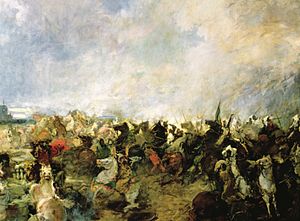Battle of Guadalete
| Battle of Guadalete | |||||||
|---|---|---|---|---|---|---|---|
| Part of the Muslim conquests | |||||||
 The Visigothic retreat in front of the Berber cavalry, as depicted by Salvador Martínez Cubells (1845–1914) |
|||||||
|
|||||||
| Belligerents | |||||||
| (Christian) Visigothic Kingdom | (Muslim) Umayyad Caliphate | ||||||
| Commanders and leaders | |||||||
| Roderic † | Ṭāriq ibn Ziyad | ||||||
| Strength | |||||||
|
~2,500 (Collins) 100,000 (Muslim sources) |
~1,900 (Collins) 187,000 (Christian sources) |
||||||
| Casualties and losses | |||||||
| Unknown, but included many nobles and the king | Unknown | ||||||
~2,500 (Collins)
33,000 (Lewis)
~1,900 (Collins)
12,000 (Lewis)
The Battle of Guadalete was fought in 711 or 712 at an unidentified location between the Christian Visigoths of Hispania under their king, Roderic, and an invading force of the Muslim Berbers and Arabs under the Berber commander Ṭāriq ibn Ziyad. The battle was significant as the culmination of a series of Berber attacks and the beginning of the Islamic conquest of Hispania. In the battle Roderic lost his life, along with many members of the Visigothic nobility, opening the way for the capture of the Visigothic capital of Toledo.
The battle is sometimes referred to as the Battle of Jerez de la Frontera, Battle of La Janda, Battle of the Río Barbate, or Battle of the Transductine Promontories.
The primary source for the battle is the Mozarabic Chronicle, which was written shortly after 754 probably in the vicinity of Toledo. The Latin Chronicle was written by a Mozarab Christian. The only other Latin Christian source written within a century of the battle is the Historia Langobardorum of Paul the Deacon. Paul was neither Visigothic nor Hispanic, but was writing probably in Montecassino between 787 and 796, where many Visigothic monks had taken refuge. The Chronicle of 741 is a near-contemporary Hispanic source, but it contains no original material pertaining to the battle. Several later Latin Christian sources contain descriptive accounts of the battle that have sometimes been trusted by historians, most notably the Chronicle of Alfonso III, written by Alfonso III of Asturias in the late ninth century. The high medieval accounts, such as that of Lucas de Tuy, are generally untrustworthy, containing much legend and invention.
...
Wikipedia
